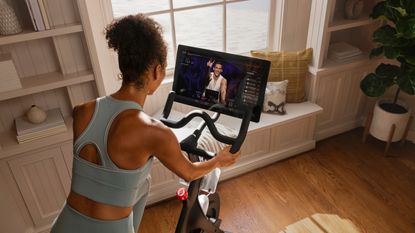Peloton Bike review
Can the Peloton Bike still impress after the hype has died down? Our reviewer puts it to the test

While it may be an investment (particularly when you consider the setup and delivery fee), between the solid design, smooth riding experience, and huge variety of cycling classes, the Peloton Bike is a great choice for any cycling enthusiast looking to invest in a better at-home workout experience.
-
+
Immersive at-home cycling experience
-
+
Peloton All-Access Membership gives you access to the best at-home cycling and fitness classes in the industry
-
+
Compact design makes it a great option for small spaces
-
-
Lacks some of the features of newer at-home spin bikes
-
-
Pricey delivery and setup fee
Livingetc knows design.

A little history: the first Peloton Bike sold back in 2013 on Kickstarter before launching a wider release in 2014. While the Peloton Bike was steadily gaining notoriety with spin enthusiasts, the brand’s popularity exploded on a much wider scale during the COVID-19 pandemic, when people were forced to find new ways to work out at home.
While Peloton has since launched additional products, their original Peloton Bike remains one of their most beloved and in-demand offerings. And for good reason! With a host of features that recreate the experience of cycling in a high-end studio (including a 22” touchscreen console, easy-to-adjust seat and handlebars, and access to an unparalleled library of both live and on-demand classes), the Peloton Bike set the standard for at-home cycling.
In this Peloton Bike review, we’ll go in-depth on all the reasons why the original Peloton Bike remains one of the best at-home cycling bikes on the market—including everything you need to know about the Bike’s features, functionality, and benefits.
Want to learn more—and whether it’s the right bike for you? Read on for the full Peloton Bike review or, for more fitness picks, head on over to our guide to the best exercise bikes.

Peloton Bike: price and availability
The Peloton Bike retails for $1,495 USD, plus $250 for delivery and setup.
If you want any add-ons with your bike, Peloton also offers a variety of packages, including Bike Starter (which retails for $1,720 and includes the Peloton Bike, a pair of cycling shoes, a set of light weights, and a bike mat), Bike Select (which retails for $1,825 and includes everything in the Bike Starter package plus a Peloton X Camelbak® water bottle and heart rate band), and Bike Ultimate (which retails for between $1,935 and $2,035 and includes everything from in the Bike Starter package plus a reversible workout mat, heart rate band, and set of dumbbells).
When you purchase a Peloton Bike, you’re also required to purchase the Peloton All-Access Membership, which gives you access to Peloton’s library of classes (more on that later) and will run you $39 per month.

Peloton Bike: setting it up
I personally didn’t assemble the Peloton Bike. Delivery and setup are a mandatory part of every Peloton Bike purchase (and, as mentioned, will add $250 to the price).
Once I scheduled my delivery date, the process was pretty straightforward; the assembly crew showed up with the Peloton, asked where we’d like the Bike assembled, and then got to work. All in all, the setup process took about 30 minutes.
One thing I love about the Peloton Bike is how compact it is. At just 59 inches in length, 23 inches in width, and 53 inches in height, the Peloton Bike easily fits into the corner of our bedroom. (Peloton does suggest leaving 24 inches of space on all four sides to ensure you have space to comfortably get on and off the bike and for workouts that include upper body work.)

Peloton Bike: use and the cycling experience
The Peloton Bike was arguably the first bike to start the at-home cycling craze—and it remains one of the best. The Bike comes equipped with a 22” high-definition touchscreen and Bluetooth connectivity that creates a fully immersive cycling experience; when I pop in my headphones and tune into the screen, it’s easy to forget that I’m working out in my bedroom—and not actually attending in person at the studio.
Adjusting the seat, handlebars, and the screen is smooth, fast, and easy (which is a must, as I’m constantly having to readjust the Bike after my husband, who is a solid 6 inches taller than me, does a workout). The riding mechanics are great; the bike feels stable, the pedaling is smooth, and the riding experience parallels anything you’d find in an upscale cycling studio.
I was also impressed with the Peloton Bike’s resistance mechanics. With some other cycling bikes I’ve tried, changing the resistance can be a hassle; one too few turns, and you don’t feel any change in resistance—but one too many turns, and all of a sudden you feel like you’re pedaling through concrete. The Peloton Bike’s resistance knob is much more intuitive; it’s super easy to make even minor adjustments to the resistance, both up and down—and since the Peloton offers 100 levels of resistance, that translates to a better, more nuanced cycling experience.
One thing to note is that, to use the Peloton Bike, you’ll either need to invest in cycling shoes (the Peloton Bike uses Delta-compatible cleats, although you can attach your own pedals if you have a different type of shoe you prefer) or contact their sales team to purchase toe cages, which would allow you to ride with regular running shoes. So, if you don’t already have cycling shoes—and cycling shoes that will work with the Peloton Bike—that’s an additional cost to consider.
The Peloton Bike is also missing some of the bells and whistles that you’ll find on some of the newer at-home cycling bikes (like a swivel screen to more easily transition to floor workouts or the ability to stream Netflix while you workout), but for me, that was, at worst, a minor inconvenience—and certainly not a deal-breaker.
While I spent nearly all my time on the Peloton Bike doing classes (more on that in a minute), you don’t have to take a class in order to get a workout in. The Peloton Bike also offers a “Just Ride” feature, scenic rides, and the recently launched Peloton Lanebreak, a workout video game where you navigate a virtual course and adjust your cadence, resistance, and output to collect points.

Peloton Bike: classes and the Peloton app
The Peloton Bike is a solid piece of machinery. But where Peloton really shines is, without a doubt, their classes.
No one in the industry does classes as well as Peloton. Not only does Peloton have the most engaging instructors (I’m looking at you, Cody Rigsby), but they also have such a huge library of classes, there is something for every rider, every workout, and every mood.
Feel like getting your sweat on while you belt out Disney tunes? Try Cody Rigsby’s 20-minute Spotify Disney Hits Ride. Want to knock cardio and strength out at once? Try Intervals & Arms—which, as the name suggests, combines cardio intervals with upper body strength training. Dealing with joint issues—but still want to get in a great workout? Try a Low Impact Ride, which builds strength and speed in the saddle.
In addition to the Bike workouts, Peloton also has a huge variety of classes to take off the bike, including yoga, strength, cardio, and boot camp classes.
With so much variety, it’s easy to just choose a workout to fit whatever mood, music style, or fitness goal you’re targeting on any particular day. But for users that want more structure in their workout regimen, Peloton also offers a variety of programs—like You Can Ride, a three-week program designed to help new riders get comfortable on the Peloton Bike; Beginner Strength, a six-week program for strength newbies; or Discover Your Power Zones, a five-week program that helps you set your “power zones” for a more targeted workout experience.
Peloton Bike: our verdict
Final verdict? There’s a reason that the Peloton Bike has a near-cult-like following. Not only is the Peloton Bike a great piece of fitness equipment, but the Peloton classes offer the best workout experience in the at-home fitness market—making the Peloton Bike a must-try for any at-home cycling enthusiast.
About this review
Deanna is a freelance writer for Livingetc based in the US, covering a range of fitness devices and smart tech for the site. This Peloton review was based on her own experience with using the bike for workouts at home, having previously purchased it. As stated in the review, she also had use of the Peloton All-Access Membership and Peloton cycling shoes throughout the testing process.
Be The First To Know
The Livingetc newsletter is your shortcut to the now and the next in home design. Subscribe today to receive a stunning free 200-page book of the best homes from around the world.

Deanna deBara is a freelance writer living in the Pacific Northwest. A fitness enthusiast, she's been writing on all things health, wellness, and fitness since 2016. When she's not busy writing, you can find her hiking the PNW with her husband and two rescue dogs, snowboarding, or trying out a new baking recipe in the kitchen.
-
 The Nespresso VertuoPlus is 30% Off for President's Day, and it's Kim Kardashian's Coffee Maker of Choice
The Nespresso VertuoPlus is 30% Off for President's Day, and it's Kim Kardashian's Coffee Maker of ChoiceThis sleek and stylish coffee maker was spotted in Kim's home bar, and you can currently save $60 if you buy yours from Amazon
By Lilith Hudson Published
-
 "My Apartment Will Feel So Elevatedly Cozy" — Our Edit of the Urban Outfitters' Presidents' Day Sale is Perfection
"My Apartment Will Feel So Elevatedly Cozy" — Our Edit of the Urban Outfitters' Presidents' Day Sale is PerfectionI'm all about 'bookshelf wealth' at the moment, the cozy and curated decor trend sweeping social media. Luckily, Urban's Presidents' Day Sale is chock-full of goodies
By Brigid Kennedy Published
-
 This Designer's "Library Table" is my New Favorite Trend to Make a Home Feel More Sophisticated
This Designer's "Library Table" is my New Favorite Trend to Make a Home Feel More SophisticatedThe "bookshelf wealth" trend is coming to your entryway and coffee tables — here's how to make it work
By Hugh Metcalf Published


